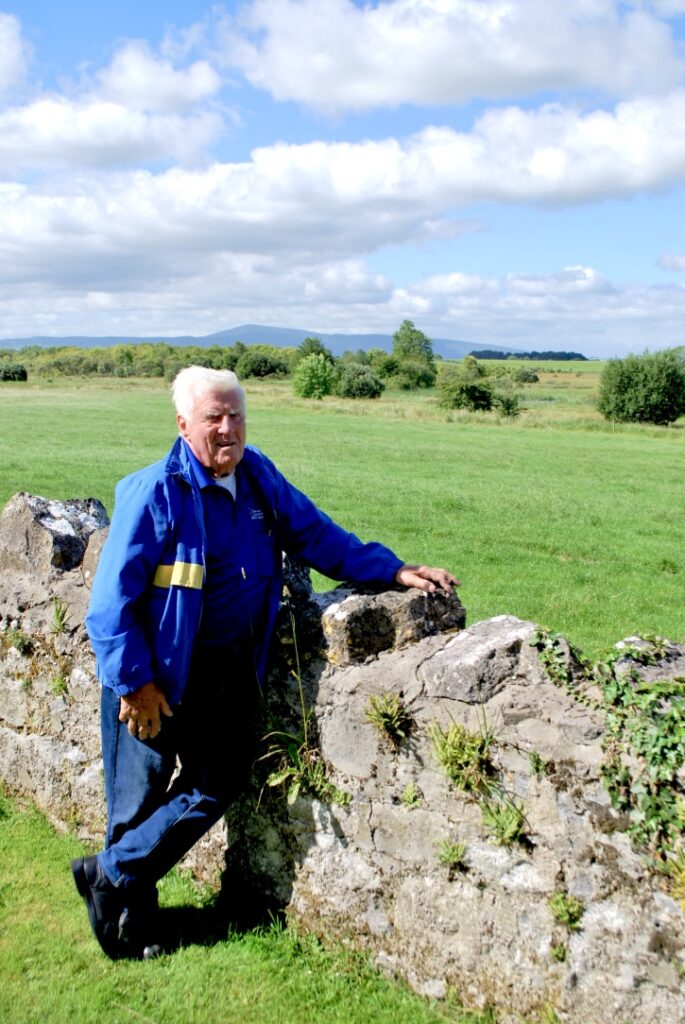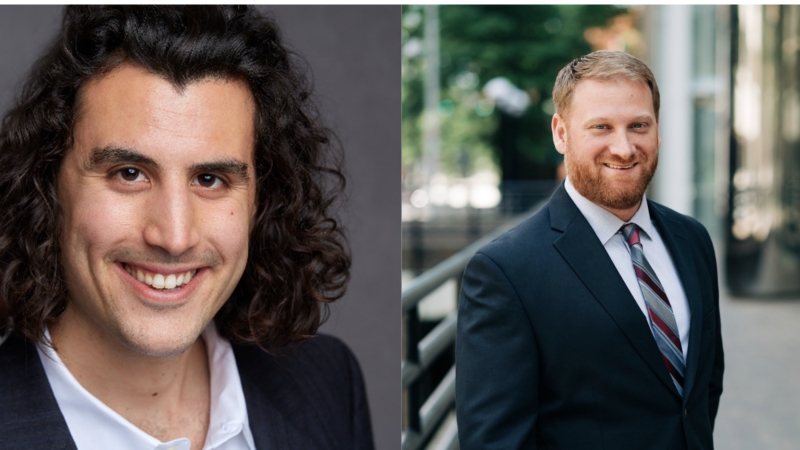RV Park Developer George O’Leary Publishes Autobiography

George O’Leary admiring the countryside in County Tipperary, Ireland, where he grew up and where his ancestors lived for hundreds of years. He still maintains a home in the Beechwood area, near Nenagh, Ireland. (Photo courtesy of Jeff Crider)
The O’Learys of Beechwood is an autobiography that documents more than 250 years of O’Leary’s family history in Ireland as well as his personal grit and determination to become a successful RV park operator
George O’Leary has cemented his legacy in the private park business not only with his recent $1 million donation to the ARVC Foundation’s School of RV Park and Campground, but with the publication of business biography and family history.
O’Leary plans to discuss his self-published book, The O’Learys of Beechwood, during Arizona ARVC’s Conference and Tradeshow, June 7-9 at WeKoPa Resort in Ft. McDowell.
The 226-page book is both a business biography and family history. In addition to providing details O’Leary’s early years in Ireland, his decision to immigrate to the U.S. and his subsequent success in the RV park business, the book carefully documents the key roles that several of O’Leary’s ancestors have played in the history of Ireland.
The book traces O’Leary’s family history to the Battle of Kinsale in 1601, when the first known O’Learys migrated from Millstreet in County Cork to the Beechwood area of County Tipperary, near Nenagh, where members of the O’Leary family have resided for nearly 300 years. O’Leary still maintains a home there on land that has been in his family’s possession since the 1760s.
O’Leary spent more than five years writing the book, which was edited by Dr. Conor Reidy, an Irish historian based in Nenagh, and Jeff Crider, a longtime Woodall’s Campground Magazine contributor and publicist, who made two trips with O’Leary to Ireland to gather additional historical information and photos for the book.
The O’Learys of Beechwood cites a combination of newspaper and historical reports to document key events in Ireland’s history as well as the efforts of O’Leary family members to protect the Catholic Church and to secure Ireland’s independence from England.
O’Leary’s great uncle, Edmund O’Leary, was commended by Pope Pius VI for his efforts to protect the Catholic Church and the College des Lombards in Paris during the French Revolution of 1789, when churches and ecclesiastical schools came under attack. Two of O’Leary’s great uncles studied Catholicism in Paris in the late 1700s, when Catholicism was outlawed in Ireland by the British.
Meanwhile, several of O’Leary’s ancestors fought to help Ireland secure independence from England. O’Leary’s great, great grandfather, Mortimer Darcy, was flogged by the British for his involvement in the Rebellion of 1798 in Nenagh. Another great grandfather, Dan Darcy, was arrested for his involvement in a Fenian Brotherhood plot to overthrow the British government in 1865.

George examines the graves of two of his ancestors, O’Leary priests Michael and Edmund O’Leary, both of whom received their ecclesiastical training in Paris before coming home to Ireland, where they served at St. Cronin’s Church in Roscrea. Edmund O’Leary helped keep the College des Lombards seminary open in Paris during the height of the French Revolution as anti-clerical activities intensified. Pope Pius VI commended Edmund O’Leary and other Irish priests for their bravery and commitment to the Catholic faith. according to published reports cited in George O’Leary’s book, The O’Learys of Beechwood. (Photo courtesy of Jeff Crider)
O’Leary’s great uncle, Ned O’Leary, was a gunrunner for the Irish Republican Army (IRA) in the early 20th century who was once captured and held in the Belfast Jail, according to his Official Witness Statement to Ireland’s Bureau of Military History. O’Leary’s father, George O’Leary, was also an IRA man who narrowly escaped execution by the British
“My mother told me my father was nearly killed because of his involvement with the IRA,” O’Leary writes in The O’Learys of Beechwood. “One Sunday, she said, a British military truckload of soldiers came through the area, stopped at our house and took my dad with them. They planned to prosecute him and eventually shoot him as he was standing handcuffed and blindfolded against a wall at the crossroads where my brother Bob’s house now stands. My father’s life was spared by the intercession of the local police sergeant, who asserted that my dad was OK and should not be shot. They took the sergeant at his word.”
O’Leary’s father died of complications from jaundice just before his 8th birthday.
“My father was an old IRA member,” O’Leary writes. “I remember very clearly the volley of shots over his grave. They were startling for a 7-year-old. Many who attended his funeral were members of public bodies, including officers from the National Army and plenty of Republicans.”
As one might expect, the death of O’Leary’s father would change his life forever. “Through no fault of his own, my dad left behind four children under the age of 8 and a widow who had not yet reached her 45th birthday,” O’Leary writes. “The dynamic in our household had now changed forever. At the tender age of almost eight, I suddenly found myself in the extraordinary position of having unofficially become the ‘man of the house.’”
The book recounts many details of O’Leary’s childhood in Ireland, the powerful influence of his mother as well as other people who shaped his early life, including Katie O’Loughlin, the much-loved nanny who helped raise the O’Leary children, and Larry Flynn, the elementary school teacher who became a father figure to O’Leary during his formative years.
The book describes O’Leary’s first construction jobs and his decision to leave Ireland in 1956 for North America to seek new opportunities, the first of which was working as a heavy equipment operator at a uranium mine on the north shore of Lake Athabasca, near Canada’s Northwest Territories.

George O’Leary (second from right) departed Ireland by boat for Canada, traveling with other young Irish immigrants, including from left, Jimmy Stapleton, Sean McKenna and Michael Slattery, right. (Photo courtesy of George O’Leary)
O’Leary immigrated to the U.S. in 1957 and eventually launched a construction business in St. Paul in 1959, which he operated for a decade until he learned of an opportunity to develop a mobile home park in Tucson. It was in Tucson where O’Leary recognized the growth potential of the RV industry and set about the task of building his own RV parks. He eventually moved his family to Tucson, starting work on Rincon Country East RV Resort in 1979 and Rincon Country West RV Resort in 1983.
The book documents the many early challenges that O’Leary faced with Tucson city officials and lenders as he worked to develop his RV park businesses. It also highlights the secrets to his success, which include setting clear goals and never giving up; hiring good people and treating them well; and being actively involved with industry associations like ARVC, which provides valuable education and networking opportunities.
Most of O’Leary’s staff at both Tucson resorts continued to work with him for decades, he said, providing continuity in quality of service while underscoring the lack of turnover that results from treating staff members well in the first place.
O’Leary also credits his involvement with industry associations for connecting him with RV park pioneers who mentored him in his early days, when he needed guidance to build his own RV park businesses. Those pioneers included Pat Korasil, the owner of Miracle Mile Trailer Park, and George Gregory, the owner of Crazy Horse Campground, two campgrounds that had no more than 100 spaces each.
“Both gentlemen are long since deceased,” O’Leary writes. “But they were the ones who hauled me to campground owner meetings in Mesa and Phoenix and inspired me to take on leadership roles in both the Arizona Association of RV Parks and Campgrounds as well as the National Association of RV Parks and Campgrounds.”

George at Irish Famine Memorial near Ennistymon, Ireland
O’Leary served on the boards of both Arizona ARVC and national ARVC and won the industry’s highest awards at both the state and national levels. These include the Jack Denton Memorial Award in 2014, the highest award presented by Arizona ARVC, and ARVC’s Park of the Year Awards, which his two Rincon Country RV Resorts won in the Mega and Large Park categories in 2018. It was the first time anyone in history had won ARVC’s Park of the Year Awards in two different categories at the same year.
In 2021, O’Leary donated $1 million to ARVC’s School of RV Park and Campground Management, providing full scholarships to park operators who would like to further the education.
While the The O’Learys of Beechwood is an autobiography that documents O’Leary’s personal grit and determination to become a successful RV park operator, he also acknowledges that his successes also came at a high personal cost as a result of his workaholism, a problem that afflicts many private park operators.
“Many people like me will repeat what I have done during the last 50 years. My advice is, don’t let it start,” O’Leary writes. “Workaholism can take over your life before you know it. It’s almost as bad as becoming an alcoholic. Don’t let it happen to you. Put your family first. If you think you need help, get it before it damages your health and your relationships.”
O’Leary sold his two Rincon Country RV Resorts to Summit Real Estate in 2022, but continues to consult to the resorts as needed.
The O’Learys of Beechwood can be ordered by emailing George at [email protected]. O’Leary said he plans to donate proceeds from the book to the Community Food Bank of Southern Arizona, a charity he has supported since 1997, the 150th anniversary of the Irish Famine.
Source: https://rvbusiness.com/rv-park-developer-george-oleary-publishes-autobiography/







